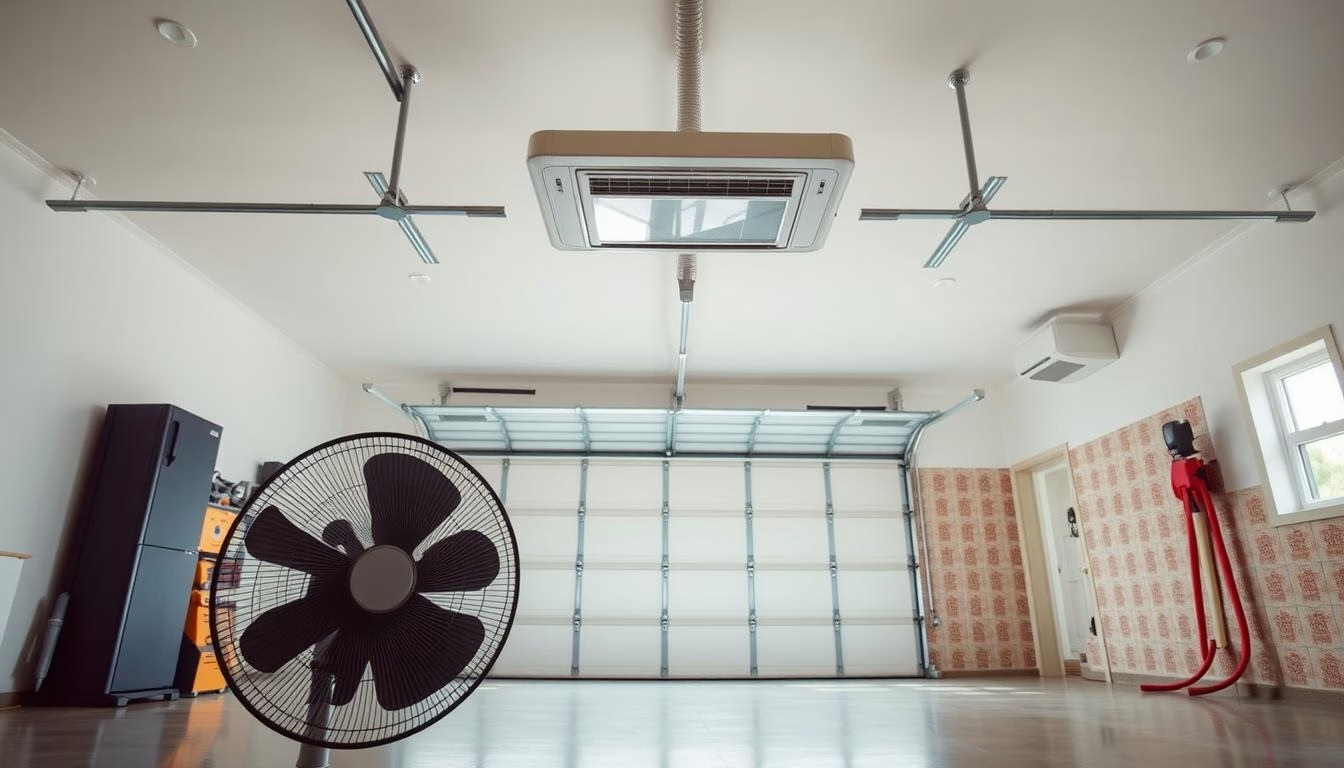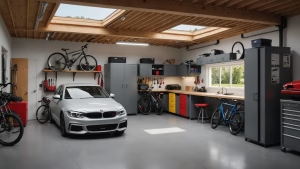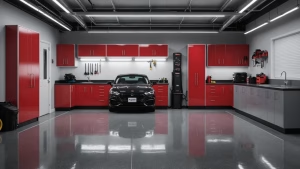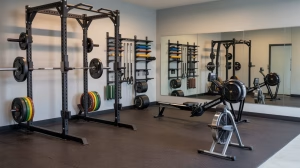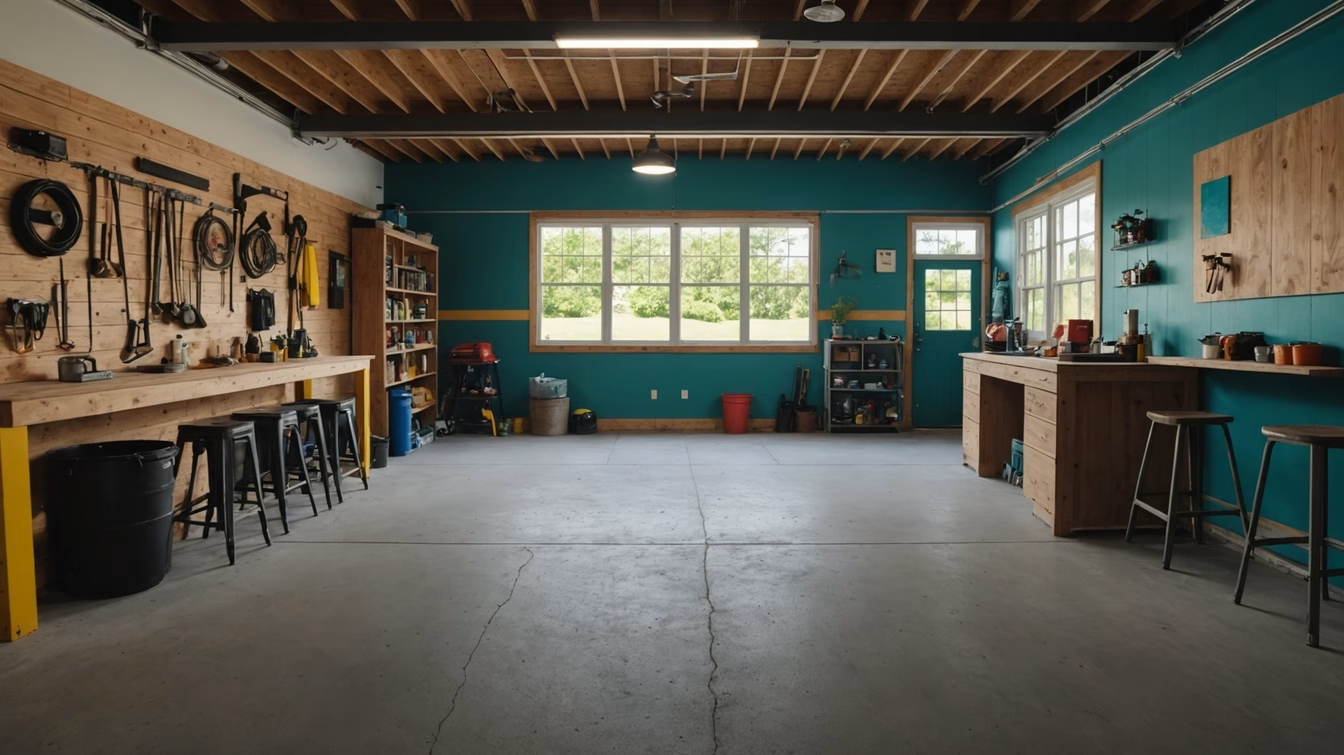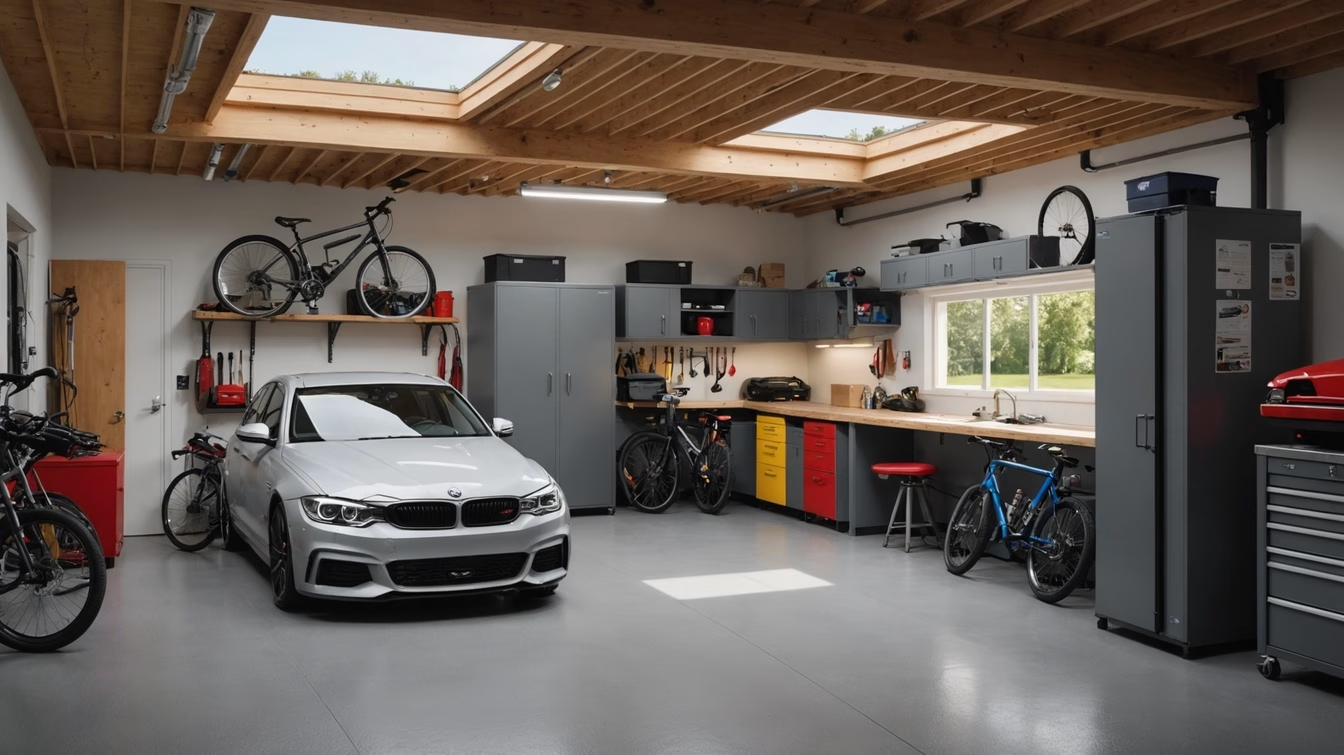Hot garages can turn a useful space into a sweltering room during summer. High temperatures not only make the area uncomfortable but also risk damaging stored items like tools, electronics, or even vehicles. Cooling a hot garage isn’t just about comfort—it’s about protecting investments and extending the usability of your space year-round.
This article explores garage cooling ideas tailored to different needs. From simple DIY fixes to advanced systems like portable air conditioners or evaporative coolers, each solution balances efficiency and cost. Whether you prioritize energy savings or quick results, the right approach ensures your garage stays cool and functional.
Why Cooling Your Garage is Essential
A hot garage isn’t just uncomfortable—it can harm stored items and affect vehicle performance. High temperatures warp wooden tools, melt plastic, and damage electronics. Cars left inside can overheat engines or degrade tires. Without proper cooling, garages become unusable for hobbies or storage. Garage cooling ideas are vital to protect investments and keep the space functional year-round.
In many U.S. regions, summer garage temperatures often exceed outdoor heat. In the South, garages can reach 120°F. Such extremes warp stored furniture, ruin paint on vehicles, and create unsafe work conditions. Poor ventilation traps heat, worsening the problem. Garage cooling ideas address these issues by reducing damage risks and creating a usable space.
Proper garage cooling extends the life of tools and equipment. A climate-controlled garage prevents rust on metal parts and keeps chemicals stable. For car owners, cooling a hot garage protects engines and electrical systems from heat stress. By prioritizing garage cooling ideas, you maintain a safe, functional workspace that adds value to your home.
Ventilation: The Key to Keeping Cool
Proper garage ventilation systems prevent heat buildup and improve air quality. Natural options like gable and ridge vents rely on wind and temperature differences to circulate air. Soffit vents combined with ridge vents create passive airflow, reducing reliance on energy-heavy solutions.
Powered garage air circulation fans boost airflow in spaces with limited natural movement. Exhaust fans and inline motors can move 100–500 CFM, depending on garage size. For example, a 20×20-foot garage needs at least 720 CFM to refresh air fully every minute. Motorized systems are ideal for humid climates where natural airflow isn’t enough.
Mechanical garage ventilation systems cost more upfront but lower energy bills long-term. Fan-only setups work for small garages, while larger spaces may need a mix of vents and motors. Check local building codes before installing any system to ensure compliance and optimal performance.
Insulation: A Cost-Effective Solution
Insulation is a key step in cooling a hot garage. Proper installation blocks heat flow, reducing reliance on cooling systems. Effective tips for cooling a garage include using the right materials to trap air.
Popular options include fiberglass batts (R-11 to R-38), rigid foam boards (R-5 per inch), and spray foam (R-3.6 to R-6.5). Reflective barriers and cellulose add options. Choose based on climate and budget.
Properly insulated garages save 10-30% on energy. Temperature differences between insulated and uninsulated can reach 15°F. Insulation also helps in winter, making it a year-round solution.
Start with attic and walls. DIY materials like fiberglass are easy, but spray foam might need pros. Combining insulation with other tips for cooling a garage maximizes comfort. Check local climate zones to pick the right R-value.
Fans: Affordable and Effective Options
Fans are a practical choice for garage cooling. The best garage fan for cooling depends on your space and setup. Garage air circulation fans improve airflow, reducing hot spots and humidity. Ceiling fans mount permanently, spreading cool air evenly. They work best in open spaces but require installation. Oscillating fans are portable, making them ideal for smaller areas. They swing side-to-side, covering specific zones without permanent setup.
Choosing the right size starts with calculating cubic feet per minute (CFM). Multiply your garage’s square footage by 1.5. A 300-square foot garage needs at least 450 CFM. Larger garages may need multiple fans. Energy efficiency matters too. Ceiling models like the Hunter Fan Company’s residential series use less power than oscillating options. Check motor specs to compare costs.
Noise levels vary by model. Look for fans under 50 decibels for quiet operation. Durable materials like rust-resistant blades protect against moisture. Brands such as Lasko offer weather-resistant oscillating fans for garages. Regular maintenance extends lifespan. Wipe blades monthly and inspect motors for dust buildup.
Portable Air Conditioners: Flexible Cooling
Portable garage cooling units offer a versatile way to manage heat in unconditioned spaces. These self-contained systems provide targeted cooling without permanent installation, making them ideal for garages used for hobbies, workshops, or storage. When choosing garage air conditioning options, portable units stand out for their mobility and ease of setup.
Key benefits include their ability to direct cooling exactly where needed. Many models feature wheels and adjustable vents, allowing users to move the unit between work zones. They’re particularly effective in smaller to medium-sized garages, delivering 10,000 to 18,000 BTUs. Units with dual-hose designs remove hot air and manage humidity better than single-hose models, though they require proper exterior venting.
Selecting the right unit requires matching BTU output to garage size. A 200-square foot space typically needs 10,000 BTUs, while 300 square feet may require 14,000. Look for Energy Star-rated models to reduce electricity costs. Drainage options vary—some units auto-evacuate condensation, others need manual emptying. Noise levels under 50 decibels ensure minimal disruption during use.
While portable units excel in flexibility, they have limits. Full garage coverage may require multiple units, and outdoor placement of exhaust hoses is essential. Combining them with insulation or shade can boost efficiency. For those seeking flexibility without long-term commitment, portable ACs are a top choice among garage air conditioning options.
Evaporative Coolers: A Green Option
Evaporative coolers provide eco-conscious garage cooling ideas by using water and air to lower temperatures. These systems pull hot air through moist pads, where evaporation cools the air before circulating it into the space. This process consumes far less energy than traditional air conditioners.
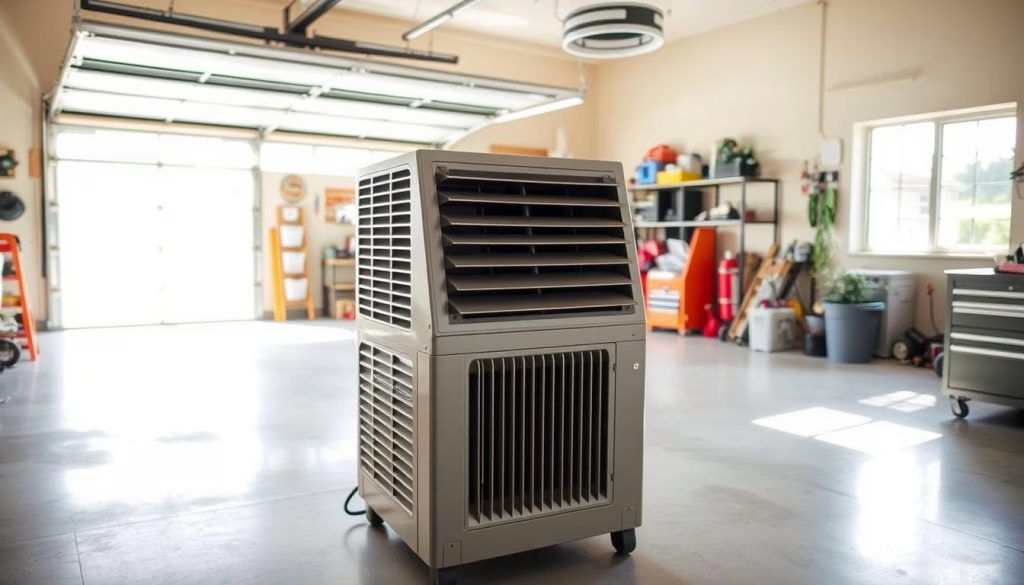
These units use up to 75% less electricity than conventional cooling systems, making them a cost-effective choice. They work best in dry climates, such as those found in Arizona, New Mexico, or Colorado, where humidity stays low. In these regions, evaporative coolers efficiently reduce temperatures without strain.
Regular maintenance ensures optimal performance. Replace cooling pads annually and clean water tanks to prevent mineral buildup. However, these systems aren’t ideal in humid areas like the Southeast, where high moisture limits their effectiveness. For those in arid zones, they offer a sustainable solution for cooling a hot garage while cutting energy costs.
Shade Your Garage: Simple Strategies
Shading your garage reduces direct sunlight, a key step in garage cooling ideas. Awnings and canopies block up to 90% of UV rays. Retractable options like those from SunSetter or Premium DuraLast let you control exposure. Permanent canopies made of PVC or aluminum can lower indoor temps by 15-20°F during peak sun hours.
Strategic landscaping adds natural shade. Fast-growing trees like river birch or hybrid poplar, planted 15-20 feet from the garage, provide dense foliage without root damage. Deciduous trees allow winter sun while blocking summer heat, enhancing tips for cooling a garage. Evergreen options like arborvitae offer year-round shade in colder climates.
Combining these methods cuts energy use and improves curb appeal. Shade reduces reliance on AC, lowering utility bills. Over time, such solutions boost property value while addressing long-term climate adaptation. Prioritize materials with 85%+ UV blockage for maximum impact.
Use Reflective Materials: A Smart Choice
Reflective materials offer a powerful way to tackle cooling a hot garage. Roof coatings made from acrylic, silicone, or aluminum can reduce roof surface temperatures by up to 50–60°F. These coatings reflect sunlight instead of absorbing heat, lowering indoor temperatures. Acrylic options resist fading, silicone lasts decades in harsh weather, and aluminum provides high reflectivity. Applying these coatings is one of the top tips for cooling a garage, especially in sunny regions.
For windows, reflective films block 50–70% of solar heat while letting light in. These films attach to glass surfaces, reducing glare and UV damage. DIYers can install thin vinyl films, but professional installation ensures long-term effectiveness. Regular cleaning with mild soap prevents dirt buildup, maintaining their heat-rejecting properties. Combining these materials with proper ventilation or shade creates a layered cooling strategy. Reflective solutions not only cut energy use but also provide lasting protection against summer heat.
Dehumidifiers: Enhancing Comfort
High humidity can make garage temperatures feel hotter and worsen air quality. Excess moisture encourages mold, rust, and structural damage. Using dehumidifiers as part of garage cooling ideas improves comfort and protects belongings. These units reduce moisture, making the space feel cooler even without lowering the actual temperature.

Signs needing a dehumidifier include musty odors, condensation on surfaces, or a hygrometer reading above 60%. Portable garage cooling units like the Frigidaire FFAD7039SS or Little Giant 72700 effectively manage moisture. Industrial models handle large spaces, extracting up to 70 pints daily, while smaller units suit workshops under 1,500 sq ft. Look for Energy Star-rated options to cut electricity costs.
Pair dehumidifiers with other strategies like ventilation or fans for optimal results. Models like the Eva-Dry ED-8500W run in unheated areas, maintaining dry air even in extreme temperatures. By combining humidity control with garage cooling ideas, you create a healthier environment without over-relying on AC units. Regular maintenance ensures these systems work efficiently year-round.
DIY Cooling Solutions: Get Creative
For those on a budget, DIY garage cooling solutions offer flexible options. Start with homemade fans. Attach a solar panel to a Honeywell box fan to create a low-cost, sun-powered vent system. Use PVC pipes to channel airflow, directing hot air out. Online guides show how to modify a whole-house fan for garage use, costing under $100 with basic tools.
Ice-based systems work in dry climates. Place a large cooler filled with ice in front of a Holmes oscillating fan. The fan blows cold air while ice melts, lowering temps 5–10°F. PVC frames can turn plastic buckets into mini swamp coolers—attach a small fan to the bucket lid and add water-soaked towels inside.
These tips for cooling a garage require no professional help. Hardware stores sell all materials: Home Depot sells solar kits under $50, and Lowe’s carries 12-inch PVC elbows for $3 each. Safety first: never leave exposed wires near water. While temporary, these projects buy time until permanent systems are installed.
Smart Technology for Efficient Cooling
Modern smart technology transforms garage cooling by adding convenience and efficiency. Smart thermostats and garage air conditioning options now allow remote control via apps, making it easy to adjust settings from anywhere. Systems like the Nest Thermostat E or Honeywell Home can monitor temperature and humidity, ensuring comfort without manual adjustments.
Integrating automation simplifies managing garage air circulation fans and climate. Motion sensors paired with smart switches can turn fans on when someone enters, while temperature sensors adjust garage air conditioning options based on real-time data. Platforms like Google Home or Amazon Alexa let users set schedules or voice-control devices, reducing energy waste.
Popular smart fan models like the Hunter Fan Company’s Wi-Fi enabled ceiling fans or Lasko Smart Oscillating Fans connect to home networks, offering remote operation. For air conditioning, the Mitsubishi Mr.Slim ductless mini-split system pairs with smart controllers, providing zone-specific cooling. Compatibility varies—check if devices work with your existing setup before buying. Installation often requires professional help, though some systems are DIY-friendly.
Cost ranges from $150 for basic smart fans to $1,200 for premium AC setups. While initial costs may be higher, energy savings and convenience make them a long-term investment. Smart technology bridges the gap between older garage systems and modern efficiency, making climate control smarter without overwhelming users.
Maintenance Tips for Your Cooling System
Regular maintenance keeps portable garage cooling units and garage ventilation systems running smoothly. Clean filters monthly to prevent dust buildup, which blocks airflow and strains equipment. Wipe fan blades with a soft cloth and lubricate moving parts like vents or motors. Check ductwork yearly for cracks or blockages that reduce efficiency.
Seasonal prep matters. Before winter, cover outdoor components of portable units and disconnect power. In spring, test all systems to ensure they start easily. For garage ventilation systems, clear outdoor vents of debris and test exhaust fans. Evaporative coolers need annual filter replacements and tank cleaning to avoid mineral buildup.
Listen for unusual noises like squeaks or rattles. Tighten loose parts or replace worn belts immediately. If a unit runs constantly but doesn’t cool, inspect the thermostat settings or refrigerant levels. Reduced airflow could signal a blocked intake or damaged duct. Contact professionals for repairs beyond basic fixes.
Maintenance extends equipment life and lowers energy costs. Small tasks like filter changes or seasonal checks keep systems efficient. Proper upkeep ensures your investment works reliably, whether you use portable units or full ventilation systems. Prioritize these steps to maintain comfort and avoid costly breakdowns.

